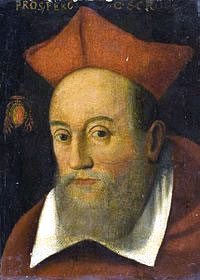Grass Santacroce, tobacco of Popes

It was the Cardinal Prospero Santacroce to do know in Rome tobacco as was then called Grass Santacroce. The Cardinal had been as papal diplomat in Germany and later ambassador in Portugal, Spain and France and it was in Portugal that he got to know a particular herb that came from the West Indies and that the natives were smoking after having rolled up the leaves or after being chopped in a pipe.
The introduction of new grass in Europe is due to the Spanish, then followed by the Portuguese, the English and French; already in 1573 there were the first crops in Spain but even before 1560 the French ambassador Jean Nicot Villemain had sent a certain amount of seeds to the French royal advising growing grass for a therapeutic use. In France for a long time the new grass, that from the ambassador's name was called Nicotiana tabacum, had been used particularly to relieve toothache and obviously it was chewing, in fact smoking was considered disreputable for the smoke that surrounded the person and pervaded the rooms.
The Cardinal saw as the new grass liked to the common people and how it was valued for its healing properties and decided to promote its import into the State Papal territories; the grass from his name was called Grass Santacroce or just Holy Grass and use soon spread to all social classes because the Grass Santacroce was considered a cure for various ailments and diseases.
Tobacco growing at least in the initial stage of its introduction was made exclusively by Cistercian monks to whom Pope Pius IV had entrusted the seeds and they cultivated them in the Roman countryside; a few years later the Bishop Nicolò Tornabuoni returned from France carried other seeds to his uncle Bishop of Sansepolcro. From there it passed to the Marches through the Cistercian monks of Clairvaux and to the Brenta Valley in the Veneto region thanks to the Benedictine monks; still today these are the territories where the cultivation of tobacco is most prevalent.
In the Renaissance, and even after, its use was considered not only useful but necessary "to priests, monks, friars and other religious, that need, and want to lead a chaste life, and suppress those sensual impulses that so much annoy, Because natural cause in libido is the heat and humidity; and when it is dried by tobacco, they do not feel those so violent sinful motions. " Many chronicles also speak of abuse of tobacco so much that in 1650, Innocent X banned to take on tobacco in the Vatican Basilica, on pain of excommunication.
Among the doctors there was also a clash between those who supported the danger that resulted from the abuse of tobacco, but they were more rumors that supported its healing properties so that they advised the use in smoke, powder, leaf and in lozenges.
Even the popes used the tobacco and a large consumer of tobacco snuff was Gregory XVI, so that his nose, already great naturally, was always so red that spread the rumor that he loved so much to drink wine, fact not true.
The Santacroce family for many years was the only one who could import the tobacco so much that even in the nineteenth century in the Papal State signboard of tobacco resales was the white cross of the Santacroce emblem.
by M.L. ©ALL RIGHTS RESERVED (Ed 1.0 - 25/11/2016)






